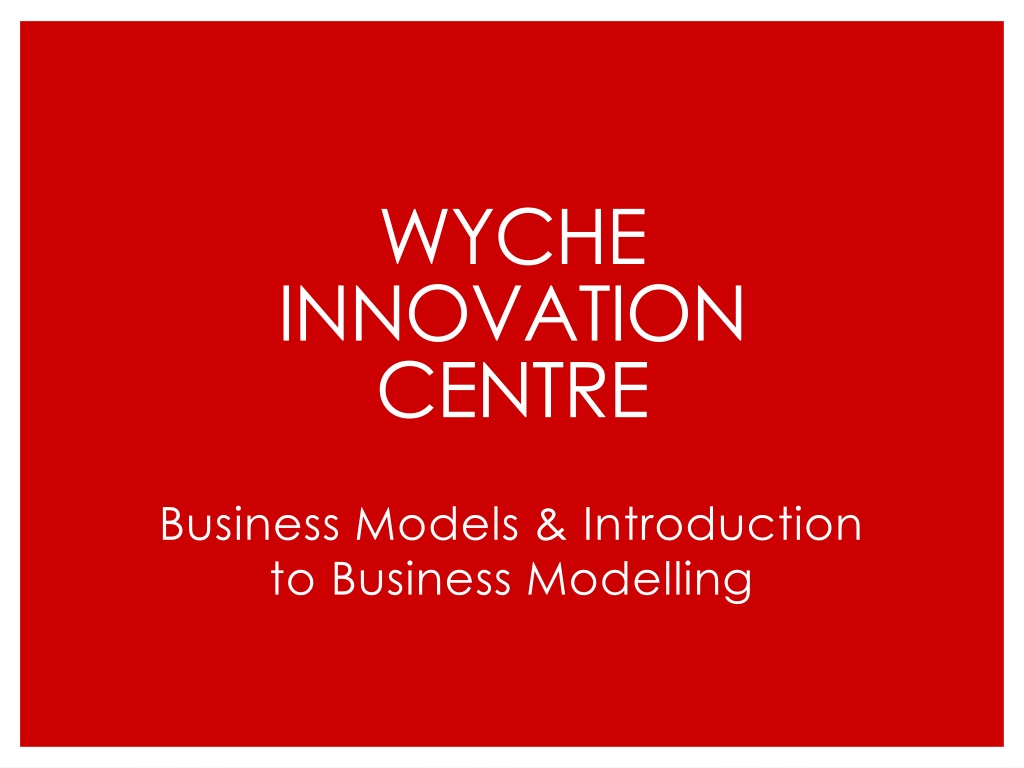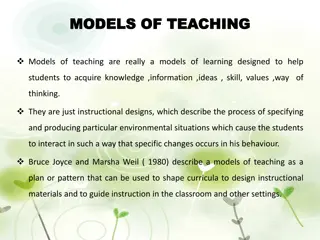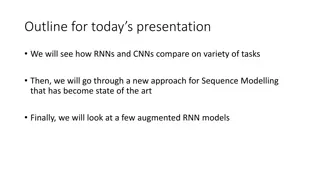
Exploring Business Models in Innovation Centers
Delve into the world of business models within innovation centers like the Wyche Innovation Centre, understanding how different models transform ideas into valuable products/services. Learn about classification, benefits of categorizing businesses based on models, and the sustainability of adopting multiple models. Explore the case study of the Wyche Innovation Centre as a real-life example in Worcestershire.
Download Presentation

Please find below an Image/Link to download the presentation.
The content on the website is provided AS IS for your information and personal use only. It may not be sold, licensed, or shared on other websites without obtaining consent from the author. If you encounter any issues during the download, it is possible that the publisher has removed the file from their server.
You are allowed to download the files provided on this website for personal or commercial use, subject to the condition that they are used lawfully. All files are the property of their respective owners.
The content on the website is provided AS IS for your information and personal use only. It may not be sold, licensed, or shared on other websites without obtaining consent from the author.
E N D
Presentation Transcript
WYCHE INNOVATION CENTRE Business Models & Introduction to Business Modelling
Learning Objectives Understand the difference between common business models Compare and contrast common business models when applied to a business
Business Models A business models is the system that transforms intangible business ideas into products/services that have value in the market place (Hedman and Kalling, 2003) Business models define: How a firm works Who its customers are What the customer values How a firm makes money How value can be delivered to the customer cost effectively Magretta (2002)
Classifying Business Models Business models provide a framework creating and delivering value to the end consumer. This can be done in the following ways: 1. Product/service provider Offers an end product or service to the customer 2. Ownership and rent of key assets Offers customers the use of a product/service 3. Finance provider Offers customers access to money and capital and associated services Tidd & Bessant (2013)
Classifying Business Models 4. Systems integrator Pulls together components on behalf of customers 5. Platform provider Offers a platform from which other businesses can create value 6. Network provider Offers access to a network 7. Skills provider Rents or sells access to knowledge or human resources 8. Outsourcer Offers to take responsibility for a non core/key activity for another business
Business Model Classification Discussion Come up with an existing business which could be categorised under each of the business model categorises What business benefits could be gained from categorising businesses based on their business model? Do you think it is a good idea for a single business to adopt several business models? How/why have you come to this conclusion? Is one business model more sustainable than other? How/why have you come to this conclusion?
Case Study: Wyche Innovation Centre In their own words: Managed by Key IQ An innovation and technology hub in Worcestershire. They provide workspaces and business services Flexible to suit the needs of both small and growing businesses. Operating an easy in and easy out policy
Video Embed/show video
Case Study Discussion Questions What type of business model(s) would you classify the Wyche Innovation Centre of currently following? How/why have you come to this conclusion? What are the benefits for the Wyche Innovation centre of having two different business models? Are there ever any potential dangers with operating more than one business model in a single business?
Mapping the Key Elements of a Business Model Many tools exist to help with the mapping and visual representation of a business (including the Business Model Canvas) When mapping the key elements of a business it is important to consider the following: What is the value proposition offered by the business? What are the key activities and resources required to realise the value proposition? Who is the customer segment is? How will the firm will generate revenue money?
Mapping the Key Elements of a Business Model Activity 1. Answer the following questions for the case of the Wyche Innovation Centre in order to map out the key elements of their business plan 2. Pick a business and answer the following questions for that business in order to map out the key elements of their business plan What is the value proposition offered by the business? What are the key activities and resources required to realise the value proposition? Who is the customer segment is? How will the firm will generate revenue money?
References Hedman, J., Kalling, T. (2003) The Business Model Concept: Theoretical underpinnings and empirical illustrations, European Journal of Information Systems, 12(1), 42-59 Magretta, J. (2002) Why Business Models Matter?, Harvard Business Review, 80(5), 86-92. Tidd, J., Bessant, J. (2013) Managing Innovation: Integrating Technological, Market and Organizational Change, John Wiley & Sons: Chichester.






















